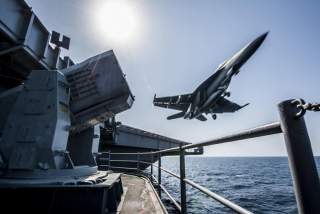How to Make the U.S. Navy Great Again
It is imperative that America’s fleet reach 355 ships within the next ten years. There is, in fact, a path to achieve this goal that is both achievable and affordable.
It is imperative that America’s fleet reach 355 ships within the next ten years. There is, in fact, a path to achieve this goal that is both achievable and affordable. Small investments now in ship maintenance and modernization could allow critical ships in the fleet to serve longer, notably among some advanced Aegis cruisers and nuclear fast-attack submarines. Additionally, there are some ships recently transferred to the inactive ready reserve force, also called the “ghost fleet,” that could be brought quickly back into our service rather than being transferred to the navies of foreign partners. Lastly, we can increase the new ship production rate on critical designs, such as the Virginia-class submarine, and accelerate the development of the Navy’s newest frigates, in order to bring these low-cost, multi-mission ships into the fleet in large numbers. The Navy has already begun this process by looking at mature foreign and domestic models, such as the Italian-designed FREMM and American-produced National Security Cutter, which have already been built and could easily be produced in numbers by American workers. These strategic approaches could convince both China and Russia that the United States is prepared to defend its interests at sea.
ALONE AMONG the services, the Navy is always deployed. In wartime, all of the services deploy. In peacetime, the Army and Air Force train and exercise but do not deploy persistently. However, the Navy, and its accompanying Marine Corps, deploy operationally twenty-four hours a day, seven days a week, 365 days a year—year in, year out, in peace and in war. This is because the very presence of naval forces demonstrates American interests without having to intrude on another nation’s sovereignty. Naval forces convey the relative importance of American interests through ratcheting up or down the number of ships in a given theater. The Navy’s unique “scalability,” along with its ability to arrive and stay, or to make its presence known and then quietly move on, gives our commander in chief military and diplomatic options.
America cannot retreat from the seas. Its maritime interests are enduring and growing. Great wealth in the form of food stocks, minerals and energy resources lies beneath the waves that find their way to our shores. Additionally, access to lines of communication via the swiftest and most efficient routes across international waters, as well as maritime linkages to forty-nine transoceanic treaty partners, are of critical interest to the United States.
The threat to those interests is growing. Despite a brief post–Cold War respite of calm seas, the maritime domain is once again seeing rough waters as an arena of economic, diplomatic and military competition. China, Russia and Iran have invested heavily in ways to keep the U.S. Navy out of critical maritime regions. They are increasingly challenging American maritime interests and finding no response. The inability to respond is driven by a collapse in the size of U.S. naval forces over the past quarter century. Our adversaries and potential opponents see all of this as an indicator of overall national decline and an invitation to assume a larger role upon the world’s oceans. They have just begun what ultimately could become a financially and strategically disastrous naval arms race in an attempt to overmatch U.S. forces in their regions.
But if the United States were to reverse course quickly on its own shipbuilding plans and pursue a 355-ship fleet within a decade, it would revitalize the Navy and safeguard American national interests.
Roger Wicker is a U.S. senator and chairman of the U.S. Senate Armed Services Subcommittee on Seapower. Dr. Jerry Hendrix is the director of the Defense Strategies and Assessments Program at the Center for a New American Security.

